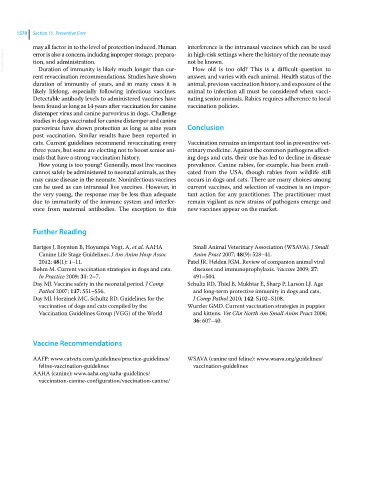Page 1632 - Clinical Small Animal Internal Medicine
P. 1632
1570 Section 15 Preventive Care
may all factor in to the level of protection induced. Human interference is the intranasal vaccines which can be used
VetBooks.ir error is also a concern, including improper storage, prepara- in high‐risk settings where the history of the neonate may
not be known.
tion, and administration.
How old is too old? This is a difficult question to
Duration of immunity is likely much longer than cur-
rent revaccination recommendations. Studies have shown answer, and varies with each animal. Health status of the
duration of immunity of years, and in many cases it is animal, previous vaccination history, and exposure of the
likely lifelong, especially following infectious vaccines. animal to infection all must be considered when vacci-
Detectable antibody levels to administered vaccines have nating senior animals. Rabies requires adherence to local
been found as long as 14 years after vaccination for canine vaccination policies.
distemper virus and canine parvovirus in dogs. Challenge
studies in dogs vaccinated for canine distemper and canine
parvovirus have shown protection as long as nine years Conclusion
post vaccination. Similar results have been reported in
cats. Current guidelines recommend revaccinating every Vaccination remains an important tool in preventive vet-
three years, but some are electing not to boost senior ani- erinary medicine. Against the common pathogens affect-
mals that have a strong vaccination history. ing dogs and cats, their use has led to decline in disease
How young is too young? Generally, most live vaccines prevalence. Canine rabies, for example, has been eradi-
cannot safely be administered to neonatal animals, as they cated from the USA, though rabies from wildlife still
may cause disease in the neonate. Noninfectious vaccines occurs in dogs and cats. There are many choices among
can be used as can intranasal live vaccines. However, in current vaccines, and selection of vaccines is an impor-
the very young, the response may be less than adequate tant action for any practitioner. The practitioner must
due to immaturity of the immune system and interfer- remain vigilant as new strains of pathogens emerge and
ence from maternal antibodies. The exception to this new vaccines appear on the market.
Further Reading
Bartges J, Boynton B, Hoyumpa Vogt, A, et al. AAHA Small Animal Veterinary Association (WSAVA). J Small
Canine Life Stage Guidelines. J Am Anim Hosp Assoc Anim Pract 2007; 48(9): 528–41.
2012; 48(1): 1–11. Patel JR, Helden JGM. Review of companion animal viral
Bohm M. Current vaccination strategies in dogs and cats. diseases and immunoprophylaxis. Vaccine 2009; 27:
In Practice 2009; 31: 2–7. 491–504.
Day MJ. Vaccine safety in the neonatal period. J Comp Schultz RD, Thiel B, Mukhtar E, Sharp P, Larson LJ. Age
Pathol 2007; 137: S51–S56. and long‐term protective immunity in dogs and cats.
Day MJ, Horzinek MC, Schultz RD. Guidelines for the J Comp Pathol 2010; 142: S102–S108.
vaccination of dogs and cats compiled by the Wurzler GMD. Current vaccination strategies in puppies
Vaccination Guidelines Group (VGG) of the World and kittens. Vet Clin North Am Small Anim Pract 2006;
36: 607–40.
Vaccine Recommendations
AAFP: www.catvets.com/guidelines/practice‐guidelines/ WSAVA (canine and feline): www.wsava.org/guidelines/
feline‐vaccination‐guidelines vaccination‐guidelines
AAHA (canine): www.aaha.org/aaha‐guidelines/
vaccination‐canine‐configuration/vaccination‐canine/

